from Sott.net
Fireball explodes over Russian city: Widespread panic and structural damage, Thousand people injured

Today was supposed to be the day when we witnessed the 'closest fly-by ever' of a space rock measuring about 45 meters in diameter. Government space agencies, 'experts' and the mainstream media have spent the past few weeks reassuring us that asteroid 2012-DA14, although coming within the orbit of some satellites, would safely pass the planet by. And indeed, it probably will have done so by the time you are reading this. But while people have fixated on this asteroid, the cosmos apparently had other plans - the actual impact of a different and totally unexpected fireball... on the same day!
At 8:45am local time today, a large fireball appeared out of the clear blue sky above South-central Russia, dramatically lighting up the surrounding region before exploding with a tremendous bang as it fragmented near the city of Chelyabinsk, located east of the Ural mountains.
Multiple smaller explosions (between 5 and 6) followed the shock wave from the initial explosion as the bolide fragmented. Eyewitnesses across a wide area have also reported seeing burning objects fall to earth, suggesting that perhaps some of the later booms were sounds accompanying meteorite impacts as debris was scattered over a wide area. Witnesses described the initial explosion as being so loud that it seemed like an earthquake and thunderbolt had struck at exactly the same time. Once the immediate danger had passed, residents of Chelyabinsk reported "huge trails of smoke across the sky".
http://www.youtube.com/watch?v=vdJrmoqsJmM
The Russian national space agency, Roscosmos, has confirmed that this space rock was one single body and that it entered the Earth's atmosphere at some 30km per second "at a low trajectory" and exploded at around 10 km above the city of Chelyabinsk, located east of the Ural mountains and some 150 km north of the Russia-Kazakhstan border. The city has a population of over a million people and is about 1500 km east of Moscow and some 150 km north of the Russia-Kazakhstan border.
According to this RT report, cell phones stopped working in the area. The fireball's electrical discharge might have produced an EMP-like (electromagnetic) effect on the area, shutting down communications, but video testimonies from local residents have been posted online all day, so some communications appear to be functioning fine. This report states that mobile connections in Chelyabinsk were shut down because a meteorite may have crashed into an antenna.
According to Russian Emergencies Ministry officials, meteorite fragments scattered by the exploding fireball hit three regions of Russia (Tyumen, Kurgan and Sverdlovsk), as well as neighboring Kazakhstan, where officials said they were searching for "two unidentified objects" that fell in the country's Aktobe region. The governor for the wider Chelyabinsk region initially claimed that "the meteorite" impacted a lake just beyond Chelyabinsk city, but this was probably just one of many meteorites that have been scattered in his region. The Russian military claims to have found three meteorite impact sites so far, including a six-metre diameter hole in the ice on Lake Chebarkul, 20 km west of Chelyabinsk. A second impact site was also found nearby while the third is said to be located 80 km to the northwest, near the town of Zlatoust.
Widespread Panic, Damage
The event was captured from countless different angles by cameras placed in office buildings, in vehicles and on street corners. If you haven't already, browse through some of them on YouTube. You'll be left in no doubt of the significance of this event. Widespread structural damage was reported, including a zinc-processing factory that apparently took a direct hit from a meteorite. The explosions also set off car alarms and damaged interiors to hundreds of buildings. In fact, RT is now reporting that nearly 3,000 buildings in Chelyabinsk were damaged by the blast, including 34 medical facilities and 361 schools and kindergartens, while the total amount of window glass shattered is estimated at 100,000 square meters. Some 20,000 emergency response workers were mobilized to Chelyabinsk, where all universities, schools and kindergartens have been closed for two days as the city tries coming to terms with the shock.
"My heart is still beating 200 heartbeats a minute! ... I saw this terrible flash, it was red-orange! My eyes are still hurting," a witness from Chelyabinsk wrote on a local web forum. "I turned off all the lights, sat the kids on a couch and waited... Oh, my God, I thought the war had begun."
There are a number of significant nuclear facilities in the region, where background radiation levels are being checked and have so far been reported as unchanged - which isn't saying much considering that Chelyabinsk has been declared the most polluted place on the planet as a result of the 1957 Mayak nuclear-fuel processing plant accident.
Latest reports from Moscow indicate that around 1,000 people have been injured, mainly residents of Chelyabinsk suffering cuts from shards of glass sent flying by the shock wave. Three people remain in critical condition. This report cites the Russian Emergencies Ministry saying that injuries resulted from meteorites from the multiple exploding fragments smashing windows in buildings, but I think that upon investigation they will find that it was the blast wave that caused structural damage, not the meteorites themselves (though certainly, a shower of meteorites also appears to have been strewn across a very wide area).
Image Gallery from Chelyabinsk
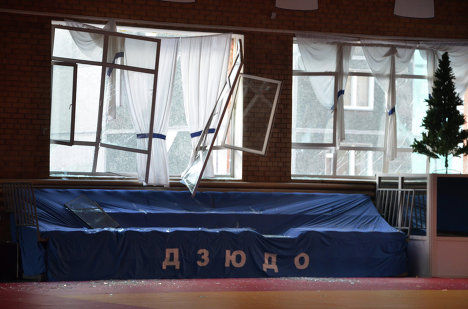
The windows of this school gymnasium in Chelyabinsk were smashed in by the shock wave from the enormous initial blast. Chelyabinsk is about 200 km south of Yekaterinburg in the Russian Ural mountains and 150 km north of the Kazakhstan border.
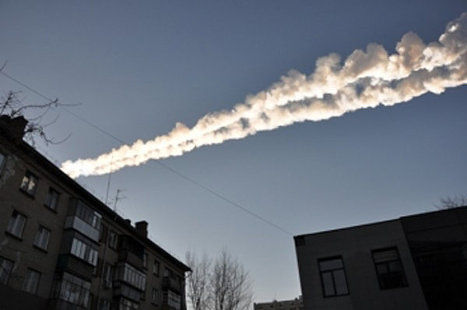
The trail or smoke plume left behind by the enormous space rock
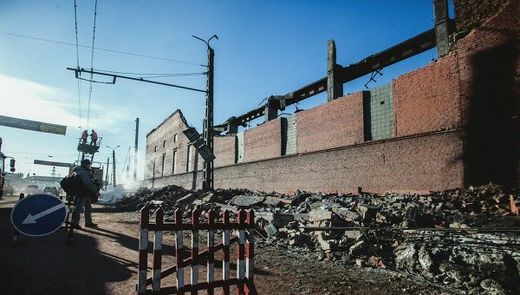
This zinc-processing factory in Chelyabinsk, Southern Russia was apparently hit by a meteorite scattered by the overhead airburst of the incoming meteor/comet fragment
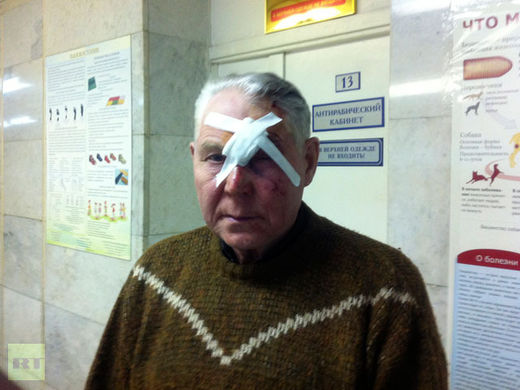
A man identifying himself as Viktor poses for a photograph after receiving treatment for injuries in a hospital in Chelyabinsk.
Raindrops Keep Falling...
Tatiana Bordovitsina, an astronomy professor at Tomsk State University in western Siberia, claimed that the meteorite could have been debris preceding the 2012 DA14 asteroid. But both NASA and the European Space Agency have stated that the two bodies are unrelated. The trajectory of the fireball in Russia was from north to south, whereas asteroid DA14's trajectory is in the opposite direction, from south to north.
They may not be directly related, but it is surely telling that this has happened on the same day that the world was anticipating the arrival of the so-called 'closest ever fly-by of an asteroid'. NASA would have us believe that it is merely coincidence that two relatively large bodies have swung past us (and into us) on the same day. Asteroid 2012-DA14 was referred to here by 'The Science Guy', scientist Bill Nye, as a 'Tunguska-class sized asteroid'. If this fireball in Russia had been in that size range, Chelyabinsk would probably have been vaporized.
While 2012 DA14 was first observed this time last year and has been closely monitored since then, here we have another (probably smaller) body that arrives out of a clear blue sky with absolutely no warning - and on the same day as the asteroid we've been repeatedly told in the past few weeks will not impact! Is 'the universe' sending us a message? Although it is technologically possible to track, name and anticipate larger bodies, what about the thousands of smaller objects that can demonstrably cause widespread damage? If you think I'm being overly alarmist here, check out this list of fireball/meteor sightings in 2013 to date:
Wed, 13 Feb 2013: Enormous fireball seen from Belgium, The Netherlands and Germany, 13 February 2013Sat, 09 Feb 2013: Blue fireball creates spectacular show over Ontario and Michigan, 9 February 2013
Sat, 09 Feb 2013: Emerald green fireball lights up mountains in Colorado and Wyoming, 09 February 2013
Fri, 08 Feb 2013: Bright fireball streaks across Nova Scotia sky, 8 February 2013
Thu, 07 Feb 2013: Fireball spotted over Fort Saint John, BC, Canada
Wed, 30 Jan 2013: Green fireball flashes across night sky in Lincolnshire, England
Wed, 30 Jan 2013: Fireball seen in the sky over Wales
Sun, 27 Jan 2013: 100 people report 'fireball' streaking across the Virginia sky Sunday night
Fri, 25 Jan 2013: Great ball of fire over Montreal, 25 January 2013
Fri, 25 Jan 2013: "Bright fireball" is a meteor in Northern Pennsylvania
Wed, 23 Jan 2013: Exploding meteorite? Confusion in Corbin, Kentucky after residents report loud, brief 'thunder roll' on sunny day
Mon, 21 Jan 2013: "Flash in the sky" above New Mexico was a meteor, 21 January 2013
Sun, 20 Jan 2013: Bright fireball a captivating sight across Kanto region of Japan
Thu, 17 Jan 2013: Fireball lights up early morning sky from Nevada to California, 17 January 2013
Tue, 15 Jan 2013: Green fireball flashes through Winnipeg sky
Sat, 11 Jan 2013: Multicolored fireball blazes over Northwestern U.S., 11 January 2013
Tue, 08 Jan 2013: Meteor sighting in skies over Moose Jaw, Canada
Sat, 05 Jan 2013: Multicolored fireball blazes over Northeastern U.S., 5 January 2013
Fri, 04 Jan 2013: Fireball and explosion in sky over Santiago del Estero, Argentina
Thu, 03 Jan 2013: Spectacular green fireball turns night into day above Northwestern Washington and Southwestern British Columbia, probably not a Quadrantid
Notice that these reports are largely confined to Anglophone countries. There may be countless other reports from other parts of the world to take into account. Then we should factor in the many reports of 'unexplained booms' and 'unusual tremors'. Are we beginning to understand that this planet is currently undergoing an alarming increase in the number of space rocks it encounters? Here is the increase in fireball flux charted from 2005-2012 and based on reports sent to and verified by the American Meteor Society:
Government Non-intervention
Russian Vice Premier Dmitry Rogozin apparently wrote on Twitter that he will "offer suggestions to Prime Minister Dmitry Medvedev on how to prevent or mitigate meteorite damage in future." In the meantime, Russia Today citing "unconfirmed reports that the meteorite was shot down by Russian air defenses" while an anonymous Russian military source told local newspaper Znak that the incoming space rock "was intercepted by an air defense unit at the Urzhumka settlement near Chelyabinsk... A missile salvo blew the meteorite to pieces at an altitude of 20 kilometers." But this claim has been contradicted by a Roscosmos statement clarifying that the space rock was not being tracked: "Our ground facilities and, as I understand, those abroad too did not the monitor this celestial body," a Russian space agency spokesman said.
We've heard that kind of tall tale before. In mid-September last year the U.S. Army claimed that a widely observed meteor or comet fragment high above Southwestern U.S. states was the result of a "test" in which it had launched a Juno space rocket then shot it down with two Patriot missiles. The Urals regional center of the Emergency Ministry claimed it sent out a mass SMS warning residents about "a possible meteorite shower". However, locals said they either never received it, or got the message after the explosion had already occurred.
This is just more of the usual nonsense put out there in an effort to contain widespread panic. To be more precise, Big Brother doesn't mind if you panic, so long as you don't direct your anger towards 'him' for not being able to do a damn thing to protect you from space hazards. As Laura Knight-Jadczyk writes in her new book "Comets and the Horns of Moses:
[...] given that human history appears to be defined by a succession of more or less corrupt ruling elites, and if we are to assume that such corruption (and its spread throughout society) is the mechanism by which a civilization attracts cosmic catastrophe, blaming and deposing the elite is a good solution. The problem, however, is that the underlying mechanism is not understood by the people, which means that they lack the knowledge that, if they are to prevent further destruction, they must, at all costs, prevent the establishment of any future corrupt elite.In the end, the people and the elite both seek a paradigm that downplays cyclical catastrophes, but they do it for different reasons. The people want to relieve the enormous stress of a certain but unpredictable major catastrophe, while the elite want to remain in power. The compromise that serves both objectives is the illusion of an elite that is able to protect the people from any disaster. This illusion can take various forms: rituals to appease the gods, revision of history displaying a uniformitarian, uneventful evolution of humanity, and lots and lots of propaganda.
This lie works well during the periods of calm between two major catastrophes. However, history shows that when famines, earthquakes and plagues have struck and taken a heavy toll, when volcanoes erupt or comets blaze across the sky or meteor storms and weather anomalies increase, the illusion collapses, the raison d'être of the elites (i.e. protecting the people) collapses and the target has always and will ever be, ultimately, the ruling classes. And they know it. Thus, when such as Anaxagoras or Socrates or Critias mention these uncomfortable facts, they are silenced by ridicule and defamation, and even death.
The symptoms of an increased cometary activity are systematically covered up by the elites as man-made phenomena. The jet contrails due to higher concentrations of atmospheric cometary dust are depicted as 'chemtrails', sprayed by government agencies, the ever more frequent overhead cometary explosions are presented as missile tests, the weather changes due to a decreased solar activity triggered by the approaching Sun's companion and its accompanying cometary swarm is labeled 'anthropogenic global warming'.
By attributing the cause of those cosmically induced events to men, the elites maintain the illusion that they are in control.
Niall Bradley has been an editor and investigative journalist for SOTT.net since 2009. He is also an editor of SOTT.net's print publication, the Dot Connector Magazine, and has appeared as a guest commentator on Press TV and internet radio shows. Niall's articles are reposted on other alt.news sites and his personal blog NiallBradley.net
Celestial Intentions: Comets and the Horns of Moses
Below we present a relevant excerpt from this first new volume: Comets and the Horns of Moses (available from all Amazon web sites).]
As I read through the piles of books on the archaeology, history (assumed and reasonably reconstructed from data), and especially the input from the sciences such as astronomy, geology and genetics that should accurately parallel the archaeology and history, but usually doesn't for all the reasons we've discussed so far, in order to collect the material for this series of volumes, the one thing that became increasingly apparent was that, over and over and over again this planet has been bombarded by various types of impacts, the most common being the overhead comet fragment air burst of the Tunguska type. These events have repeatedly brought cultures, nations, even civilizations, to their knees. Dark Ages are inevitably the result, and then, when human society begins to recover, myths are created, religions are born, or re-born with twists and distortions, and always and ever, the facts of the previous era of destruction are covered up in veils of metaphor and allegory.
Why? What sort of madness is this?
It is actually very simple. Historically, when a people begin to perceive atmospheric, geological, climatic disruption and all the ills that these bring on a society, including famine, plague and pestilence, they individually and collectively look to their leaders to fix things. That is where the concept of the Divine King came from to begin with: the king was supposed to be able to intercede for his people with the gods. If the king was unsuccessful with his intercession, a solution had to be found. Sacrifices were made, rituals were performed, and of course, if that didn't work, if the gods remained angry, then the king had to die. This is possibly due to a similar brain switch that drives people to seek whatever relieves the stress on their brain: if the gods are angry, find a scape-goat. And when it is the nation that is threatened, the most obvious guilty person or persons are those in charge, the king and his elite. What's more, they know their vulnerability to this reaction instinctively.
Then again, given that human history appears to be defined by a succession of more or less corrupt ruling elites, and if we are to assume that such corruption (and its spread throughout society) is the mechanism by which a civilization attracts cosmic catastrophe, blaming and deposing the elite is a good solution. The problem, however, is that the underlying mechanism is not understood by the people, which means that they lack the knowledge that, if they are to prevent further destruction, they must, at all costs, prevent the establishment of any future corrupt elite.
In the end, the people and the elite both seek a paradigm that downplays cyclical catastrophes, but they do it for different reasons. The people want to relieve the enormous stress of a certain but unpredictable major catastrophe, while the elite want to remain in power. The compromise that serves both objectives is the illusion of an elite that is able to protect the people from any disaster. This illusion can take various forms: rituals to appease the gods, revision of history displaying a uniformitarian, uneventful evolution of humanity, and lots and lots of propaganda.
This lie works well during the periods of calm between two major catastrophes. However, history shows that when famines, earthquakes and plagues have struck and taken a heavy toll, when volcanoes erupt or comets blaze across the sky or meteor storms and weather anomalies increase, the illusion collapses, the raison d'être of the elites (i.e. protecting the people) collapses and the target has always and will ever be, ultimately, the ruling classes. And they know it. Thus, when such as Anaxagoras or Socrates or Critias mention these uncomfortable facts, they are silenced by ridicule and defamation, and even death.
The symptoms of an increased cometary activity are systematically covered up by the elites as man-made phenomena. The jet contrails due to higher concentrations of atmospheric cometary dust are depicted as 'chemtrails', sprayed by government agencies, the ever more frequent overhead cometary explosions are presented as missile tests, the weather changes due to a decreased solar activity triggered by the approaching Sun's companion and its accompanying cometary swarm is labeled 'anthropogenic global warming'.
By attributing the cause of those cosmically induced events to men, the elites maintain the illusion that they are in control. 'Chemtrails' can be stopped if the 'sprayings' end, missile tests can be stopped if the military can be coerced to do so, global warming can be reduced by controlling man-made greenhouse gas emissions.
However, contrails triggered by increased cometary activity, overhead cometary explosions, and cosmically induced solar and weather disruptions can't be changed by the elite. Not only that, if the public realizes this, they may also begin to think that the 'gods are angry' and try to find the real reason, settling ultimately on the corruption and violence of the elite in their efforts to get and maintain greater power.
If the masses of humanity were to recognize the real causes of such phenomena, that would entail recognizing the powerlessness of the elite and therefore the end of their 'mandate from heaven'.
Mike Baillie comments:
The Chinese believed that an emperor could reign only while he enjoyed the Mandate of Heaven, that is, while he 'looked after his people'; if for any reason he failed to look after their well-being, Heaven would withdraw its Mandate and the emperor and probably his ruling dynasty would be deposed. ... Heaven would have been seen to withdraw its Mandate when the sky darkened, the crops failed and famine ensued bringing death to large numbers of people. The emperor, guilty or not, gets the blame for failing his people. In the aftermath of a calamitous dust-veil event the political upset could easily lead to the deposing of the ruling regime.
Of course, in the beginning of such times of trouble, people want to believe that their government - their kings and ruling elite - are powerful enough, or pure enough, to control nature such that the floods, wildfires, earthquakes and volcanic eruptions cease and all returns to normal. And the ruling elite take advantage of this during such times by trying to find likely scapegoats in other nations, some minority group in their own country, or their personal enemies - including those who are pointing out that it just might be their corruption that is bringing on all the evils - so as to distract the larger populace from their own possible sins of commission or omission. This means that such a period can include protracted wars and the accompanying necessary burden of taxes, persecutions of this group or that group, generally increasing social hysteria and unrest, until finally, one day, the people, as a whole, wake up and see that their rulers have behaved very badly and all the blame gets dumped on them. This is ironic because an anthropocentric worldview where man believes he is in control stops people - even people in power - from being aware of the realities of our existence on this planet which include civilization destroying cosmic events.
Victor Clube writes in The Cosmic Winter:
Even before the Black Death came, then, a human catastrophe of great proportions was under way in late medieval times. Indeed, the cold snap lasted well beyond the period of the ... plague. A number of such fluctuations are to be found in the historical record, and there is good evidence that these climatic stresses are connected not only with famine but also with times of great social unrest, wars, revolution and mass migrations.
The Horns of Moses: Creeping Mechanization
What we see in this non-exhaustive examination of the development of the ideas that underpin Western Civilization is a creeping tendency to mechanize everything. While viewing the world as really 'real' - really physical, the basis of the scientific approach - academia subtly, step-by-step, downgraded the Cosmos and all within it to little more than a self-propelling system that was, oddly, not really affected by this acknowledged really real outside world! How bizarre is that? The world became an evolutionary thing driven from evolution itself, inside the system, with no relationships to anything other than this mindlessness, especially not anything outside of the Earth! The development of these ideas in ancient Greece during that chaotic period of empire formation, together with a tendency to regard philosophers as 'useless', put a period to free inquiry. A few ideas came along during that time, including a heliocentric cosmology by Philolaus , Heracleides of Pontus and Aristarchos of Samos , but these ideas (correct ones, as it happens) went no further and the Aristotelian school of thought was promoted to the exclusion of everything else.
Certainly, Aristotle was a clever guy in many respects, but his astronomy and cosmology (not to mention his ideas about differences between the sexes) were abysmally ignorant. He stated that "exhalations" or evaporations of two kinds are continuously given off by the Earth: wet or steamy, or dry and smoky. This is all that is needed to explain everything that goes on in the atmosphere and skies. He then adds that: "Our remote ancestors have handed down remnants to their posterity in mythical form to the effect that these [heavenly bodies] are gods and that the divine encompasses the whole universe." In other words, he is saying that the primary substances are divine and are located in the heavens, but then the fiery substances that rise to become these atmospheric phenomena, are exclusively of the Earth!
Needless to say, after Aristotle, cosmological speculation fell into decline. The Aristotelian view was adopted by the Alexandrian school and, as already noted, reigned unchallenged for almost two thousand years.
The Plan
In the next volumes of this series of books, we are going to go comet hunting through history. I am going to create a chronology that includes - even emphasizes - the extremely important elements of the environment, particularly the astronomical environment, on the events of our history. What this chronology will include will be as comprehensive a listing of environmental, astronomical, geological and climatological events as I can assemble. Among these are records of Chinese astronomers revealing that a lot was happening in the skies that somehow either nobody in Europe was recording, or if they did, those records were 'lost' - accidentally or deliberately, with few exceptions. I will alternate this type of material with selected social and political events so that, at the end, we can evaluate whether or not there is a relationship between things that happen on Earth and things that happen in the heavens.
My first target in the next volume is going to be the Roman Empire, victim of our most recent Dark Age, which archaeology reveals was a devastating reduction in population and the termination of the so-called civilized processes for a very long time - within historical times.
As we go along, we will be assembling and assessing evidence that there is, indeed, a secret history (in more ways than one), and I will share some very interesting discoveries I have made in the process of collecting the materials for this chronology. I think that what I have discovered will make the case for deliberate expunging of certain records including the knowledge of what really brought on the Dark Ages. We've already seen what Greeks, in the service of rationality and politics, did to the knowledge of our reality; I think I can show, through the history itself, that what was later done on that foundation was an extraordinary process of retrogression, dominated by that singular figure in the history of Western Civilization: Moses.
The very fact that a primitive, obscure, Middle Eastern tribal god managed to acquire so much space in the consciousness of the founders of Western Civilization is as astonishing as the fact that a primitive pathological deviant rose to power in mid-twentieth century Germany and nearly brought the entire planet to its knees. In fact, the two events may have certain things in common. Hitler - and current-day oppressors working toward the same goal - would not have been able to do what they have done if it had not been for Moses and the twisted world-view that resulted from the combination of Middle-Eastern models of imperialism combined with the delusional results of the Greek Platonic astralizers and Roman ego.
I will be drawing on a significant selection of the ancient sources that we do have for the periods in question but, as you will see, rather selectively as to topic. The fact that I did it this way actually led to a startling revelation about one of these sources, as well as the solution to a 2,000 year-old mystery. I actually think that you are going to enjoy this way of looking at history, because trying to figure out What Really Happened when there are all kinds of competing agendas about truth, past and present, is actually as much fun as playing detective!
Laura Knight-Jadczyk is a seventh generation Floridian, a historian/mystic and author of 14 books and many articles published in print and on the internet. She is the founder of SOTT.net and the inspiration behind the Cassiopaean Experiment. She lives in France with her husband, Polish mathematical physicist, Arkadiusz Jadczyk, four of her five children, extended family, eight dogs, five birds and a cat.




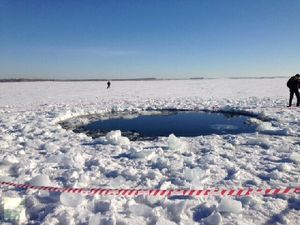

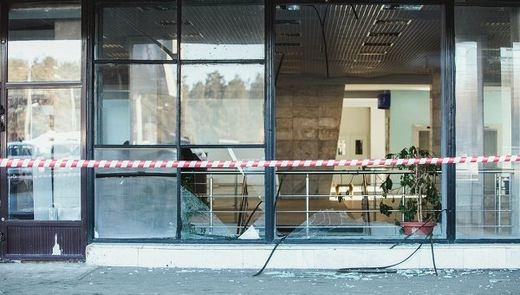

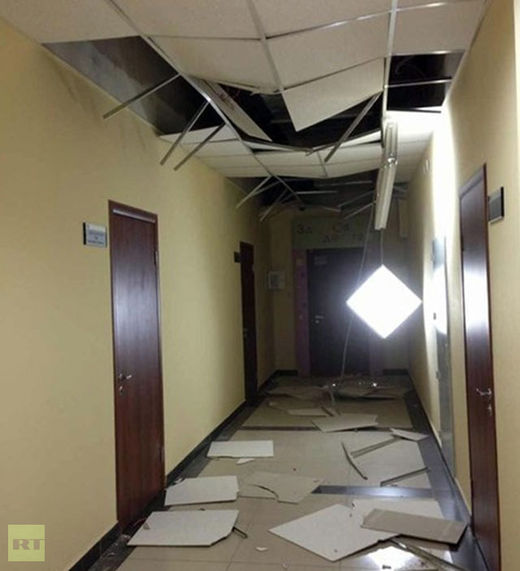

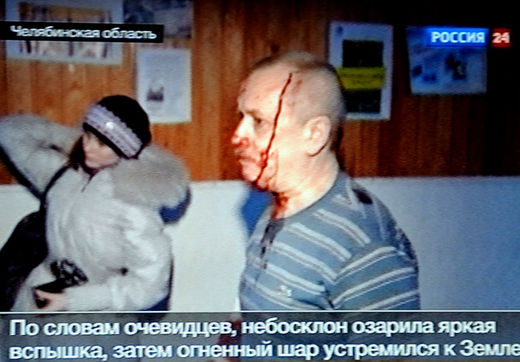
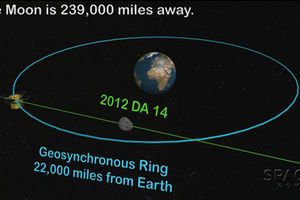
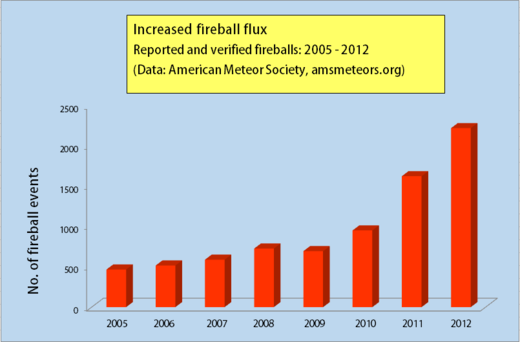

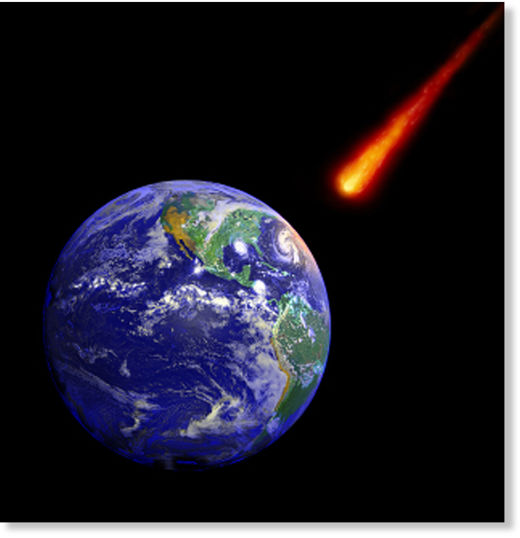
im not into the doomsday crap, "widespread panic"!.....thought this was all very cool actually.......
As the Earth passes through our galactic center and through an asteroid belt, some have predicted devastating effects from meteors impacting the earth. I think it was Clif High who predicted that such collisions would shower the Earth over a period of several months in such a way that the global food supply would be seriously threatened.
I've been wondering why I haven't heard about any increases in frequency of such events -- until now. 'Course, these days, I take Clif's predictions with a grain of salt.
I wonder what new energies that the asteroids that are hitting the Earth are seeding the Earth with.
It has certainly been interesting as a Sensitive lately for me at least.
When I have viewed the footage I could not help feeling that there was some Friends-- Cosmic Citizens looking out for the Earth-Gaia and "helped" by breaking up the asteroids so when it "hit" the Earth in the 12 or so different areas the impact was softened-- it is a sheer Miracle (science too complicated to explain) that very few people were hurt and to my knowledge no one died from direct contact with the meteorites...
This would mean Humankind and Earth-Gaia have changed the Timeline collectively by our opening of HEARTS and Loving More. I believe we are all co-creating a positive timeline.
Agreed Jez, I found the whole thing very interesting. Why is it these Meteorites always impact Mother Russia or Siberia? Anastasia had a lot to say about this in her first book transmitted through Vladmir Megre.
I bless all with Love.
Fairy